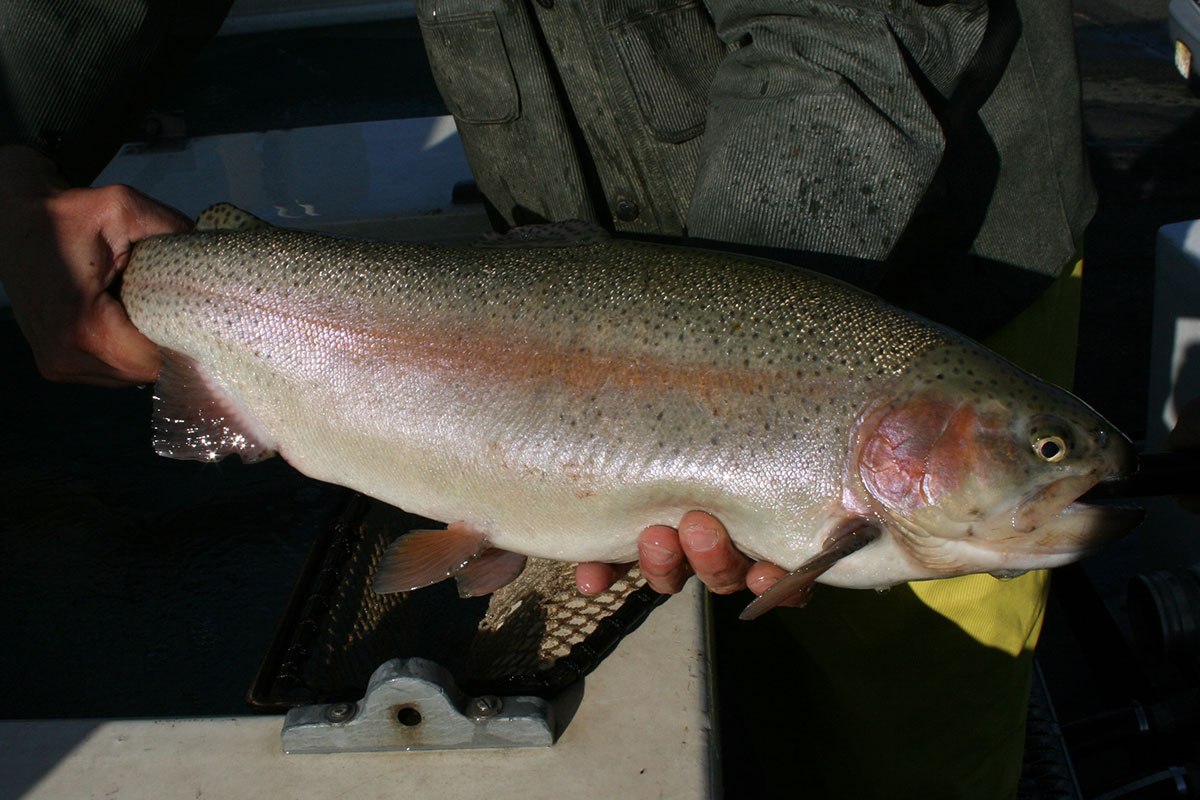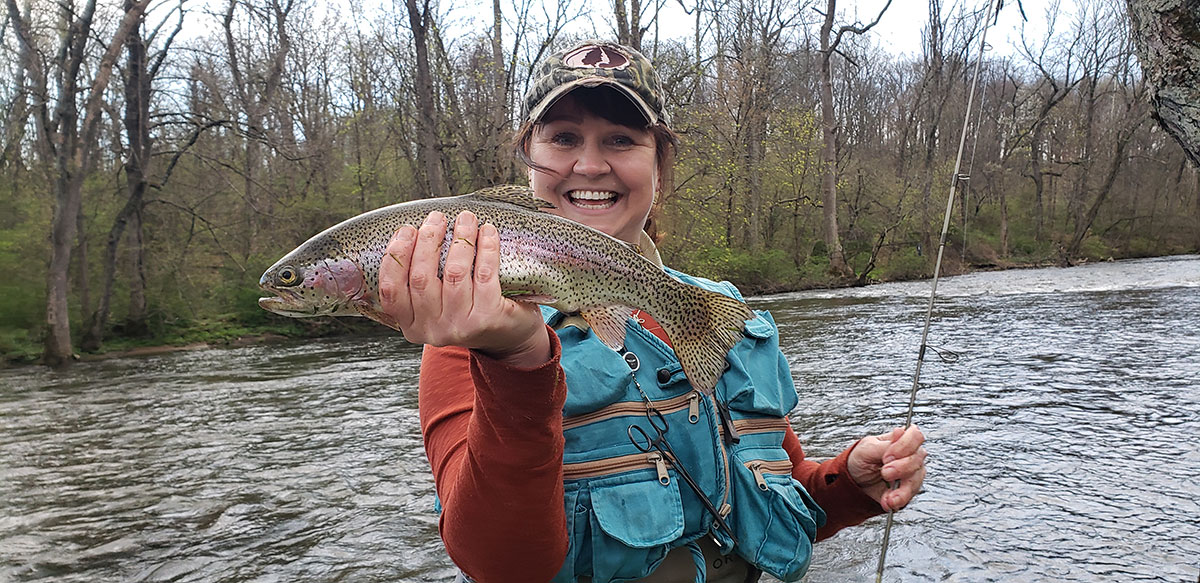
Gear up for trout season kick-off on April 6.
When the 2024 statewide trout season commences 8 a.m. on Saturday, April 6, the preliminary stocking load will have consisted of 184,360 hungry, feisty rainbows averaging 10-1/2 to 11 inches in length, let loose in 171 lakes, ponds, rivers, streams and reservoirs throughout the Garden State.
In the mix for ’24 are several thousand spent 2-1/2- and 3-1/2-year old breeders ranging from 3 to 7-plus pounds and taping to 26 or so inches. Approximately 2% of every load destined for a preseason delivery will include these heavyweights; and with approximately 7,000 of these available, look to big splashes through the second week of the seven week in-season stocking schedule.
Sweetening the opening day dosage is the Bonus Broodstock program with 10 waters (on a rotating basis) split between the north, central and southern sections of New Jersey receiving an overall total of 400 3-1/2-year-old ‘bow bombers. These are incorporated into the pre-season stocking, making for some trout-of-a-lifetime opening day and beyond, opportunities.
“The fish are in fantastic shape, and there are plenty of big breeders also being stocked to make for a great opening day,” said Pequest Trout Hatchery superintendent Ed Conley, who added “And just a reminder that more breeders will be included in the stocking loads through the second week of the schedule.”
When all and said is done, the baseline number of 569,740 rainbows will have been freed by the early afternoon of Friday, May 24. However, that number is suspect, but in a good way. As has been the case for the past decade(s), the Pequest facility, fueled by the fevered efforts of its high octane crew, has, for years too numerous to mention, produced a surplus of trout for the spring stocking season. As an example, 603,525 rainbows were released in 2023, a whopping 33,785 above the aforementioned baseline figure. As a disclaimer, this decades-long over production is a year-to-year thing, so no promises. However, going by consecutive past year deliveries history, figure s’more ‘bows as the stocking schedule progresses. (No promises, for sure, but it’s heavily odds-on that there will a bonus count.)
Conley notes that by the end of the third week of the stocking schedule, he’ll have a grasp regarding the surplus, if any, there is and then apportion as per the swims remaining on the stocking list through the end of the May 24 cessation of releases. “Weeks five through seven are when the extra fish will be added to the remaining waters being stocked,” he said.
That adds an exponential incentive to enjoy the ‘bow bounty beyond the more popular four week in-season furloughs when, save for the hardcore salmonid devotees among us, angling attentions generally turn elsewhere.
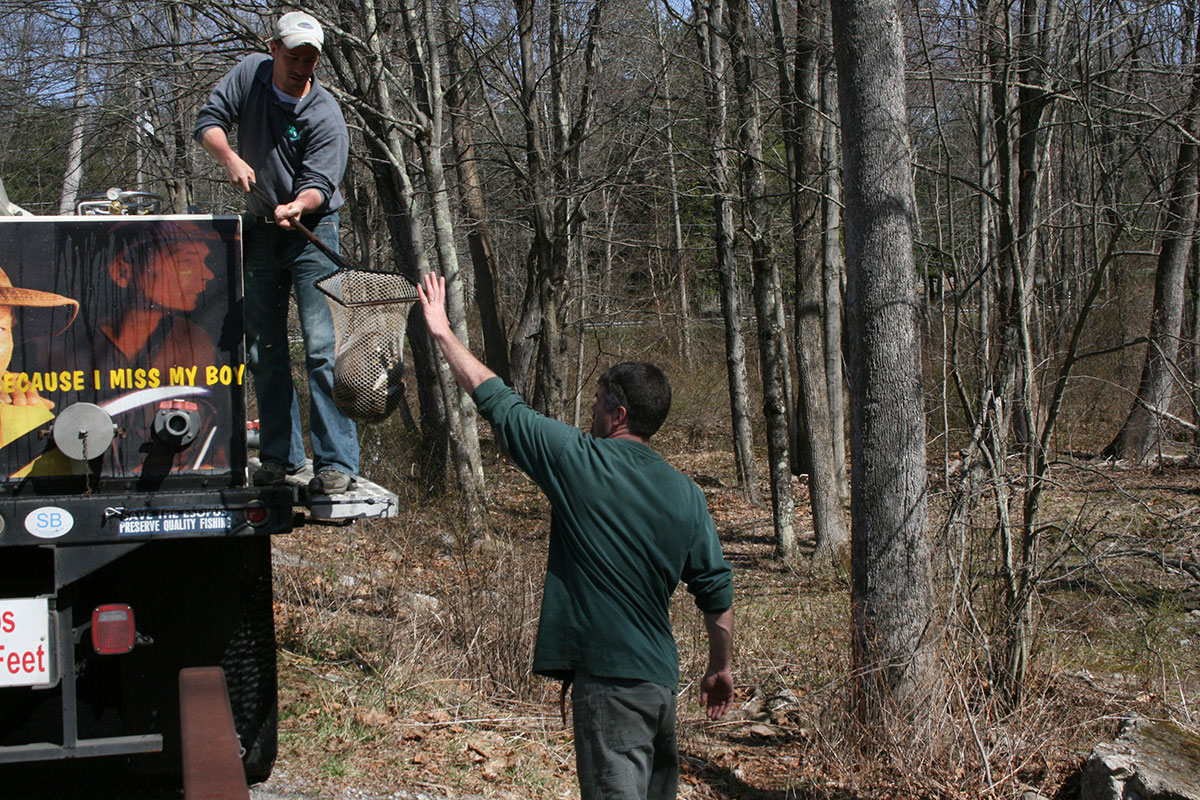
Why Still Rainbows?
| BONUS BROODSTOCK |
| Ten combined select waters in North, Central and South Jersey will be graced with a generous bump of 400 3-year-old drag screamer breeders from 3 to 6 plus pounds for the April 6th opening day which are included in the pre-season stocking numbers. Following are the recipients of the wildly popular Bonus Broodstock program, with the numbers of breeders in parenthesis after the pre-season allocation number.
Crystal Lake (Burlington County; 18 acres) – 560 (50)
|
It’s the dark 10th Anniversary of the near Pequest Trout Hatchery-wrecking outbreak of the furunculosis pathogen that severely infected brook and brown trout populations within Pequest. Rainbows were slightly affected, but to no life-threatening degree, except for stocking program/procedure schedules trashed. Long story short, nearly 250,000 of the brookies and browns were euthanized, and it was one helluva pre-season stocking as Pequest’s raceways were flushed of browns and rainbows, and whatever survivor brookies into listed “Trout Stocked Waters” statewide.
Fast forward as you’re reading this: it’s been rainbows since. Why? According to former DEP Fish & Wildlife’s pathologist Jan Lovey, the rainbows have a thicker slime layer, hence deflecting any possible infection invasion. Brookies and browns on the other hand are disease susceptible. As such, it’s been a rainbow ride since and, frankly, from a hatchery logistics standpoint, the ‘bow is the way to go. And the aforementioned pair required a staggered roe stripping/hatching process, unlike the ‘bows that are hatched in a two-week cycle. This makes for uniform growth to the 10-1/2- to 11-inch average stocking size.
Besides, rainbows are fun to catch and are game on quickly, oftentimes minutes, after release. These are tailor-made for ultralight spinning tackle and 3-weight fly setups. They are wont to strike at most anything reasonably appearing edible, and they have a penchant to go airborne at hook set before the sprint revs. A different exchange than the pit bull pull of a brown or the quick tug-pull then give it up of a brookie. Of course, rainbows are just plain pretty to look at, especially when the lateral line vestment is lit in either a scarlet, vermillion, carmine or crimson tones, with a splattering of ebony spots a stark complement.
The question is what a ‘bow won’t make a play for? Sure, get a holdover that’s survived the initial weeks’ onslaught and it can be finicky for sure, but on the overall, rainbows are meant to blast. Downsized plugs, spinners, jigs (read: Trout Magnet), meal, garden and wax worms (and butters if you can find them), baby nightcrawlers, fathead minnows, salmon eggs, kernel and Gulp Corn, along with the various Power and Gulp Dough baits, eggs garden worms and minnows, the M&M (meal worm/mini marshmallow tandem), nymphs, streamers and wets, and when a hatch is on, dry high riders…all will take a hit.
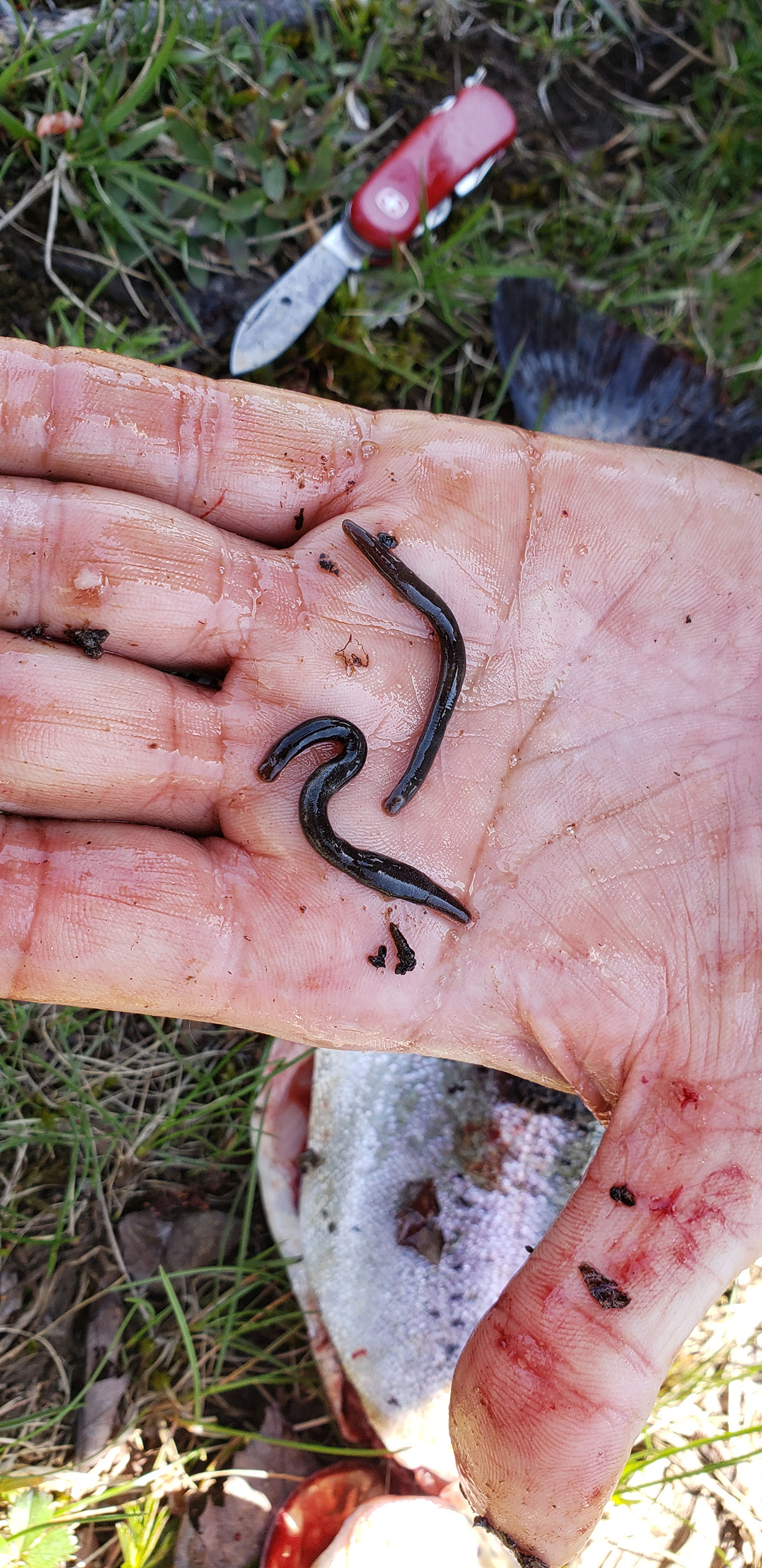
Meating Rainbows
We make it a point to target specific areas of favored swims that were stocked during October with the insolent 2-year old ‘bows. A fair percentage of these have held over and have made their ways away from the stocking points and are generally settled in the more remote and deeper, structure-strewn holes and pools. As with their brown kin, these are meat eaters; while they will pick flies floating along in the surface film, they are more prone to a mouthful of flesh.
This proved itself again one afternoon last April when angling compadre Denise Theiler was drifting an “anaconda” nightcrawler in a long, deep pool on the Musconetcong. A sharp tug transformed into 5 minutes of give and take in the thrusting current. In the net, it was observed that the husky rainbow was hooked deep, and it was decided to keep the fish for grill duty that evening. The bumps in the stomach area were a point of curiosity, and upon evisceration it was discovered that a crayfish, all 3-1/2 inches of it, sans pincers, was a very recent meal.
If seeking specimen rainbows, go big. Besides ‘crawlers, the red-sashed meat seekers will take small shiners, leeches, hellgrammites and crayfish. Hellgrammites are especially deadly. During April into May we search for them under bankside logs and rocks. They will be curled in a cell and are about to pupate before emerging as adult Dobson flies. If per chance you uncover one that it white with an apricot tint to the head, leave it be, as it will be mature within 24-36 hours.
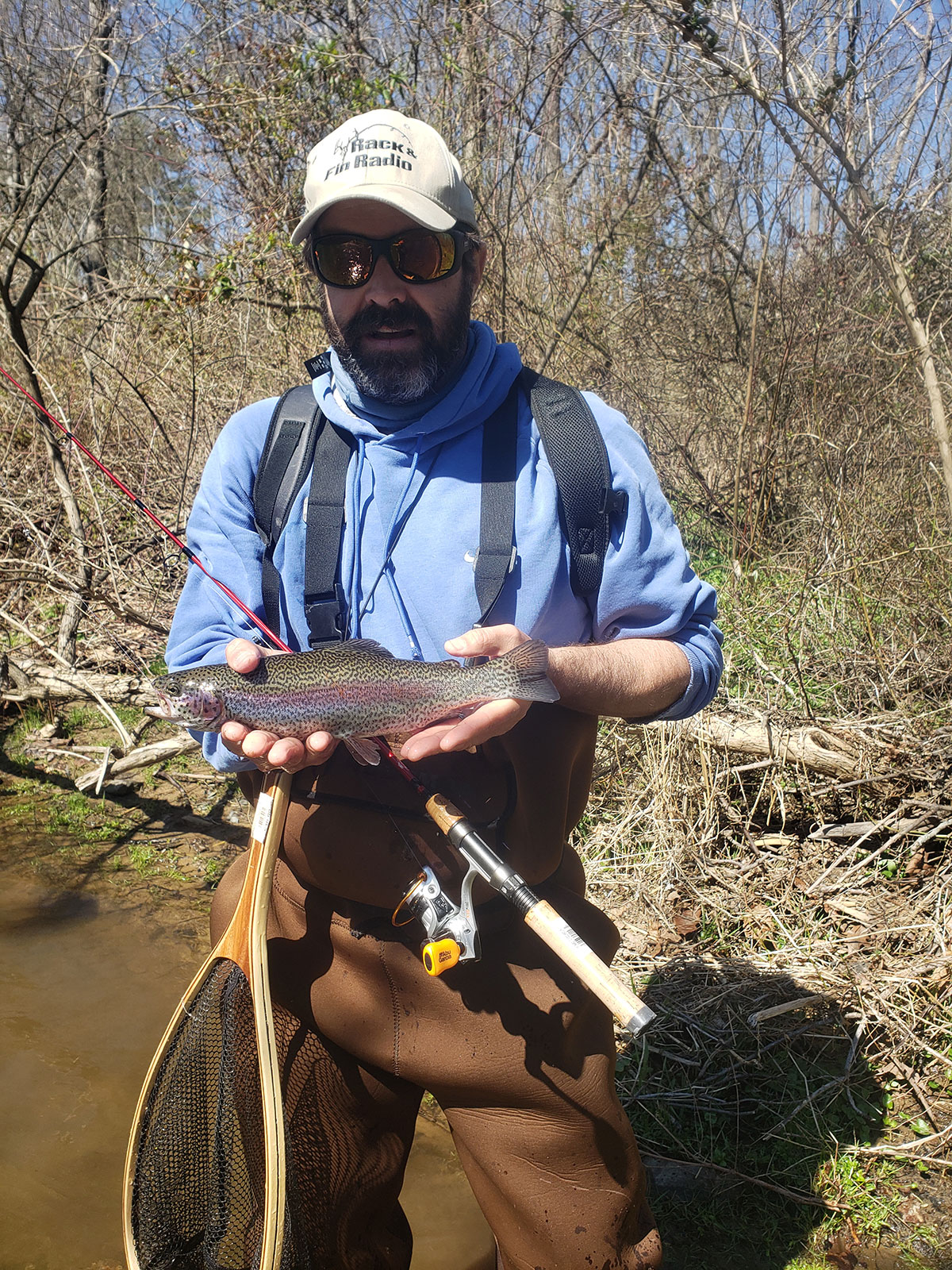
There are 16 venues with closed stocking dates wherein angling is not permitted until 5 p.m. on the stocking day. These are listed on page 18 in the 2024 NJ Freshwater Fishing Digest, and include select northern and central tier county swims. Within some of these are Seasonal Trout Conservation Areas (Pequest/1.4 miles, and Pequannock/1.3 miles), Year Round Trout Conservation Areas (Toms/1 mile and Musconetcong/1.2 miles), and Catch & Release Areas (Ken Lockwood Gorge on the South Branch of the Raritan River/2.2 miles, and the Big Flat Brook/4.2 miles). Otherwise, it’s wide open fishing, and springtime rainbows will certainly oblige, no matter the setting. Urban to suburban to bucolic, they’ll have the feedbags on.
Still waters? Try one of the Trophy Trout Lakes (Round Valley and Merrill Creek reservoirs) or any of the Holdover Trout Lakes (Aeroflex, White, Wawayanda and Sheppard lakes, and Clinton Reservoir). Landlocked salmon? Wawayanda, Aeroflex and Tilcon lakes. To be sure, New Jersey trout fishing has never been better. Sure, it’s only rainbows on the stocking roster, but don’t forget the opportunities for native brookies and wild browns via Native Brook Trout Streams, Wild Trout Streams, and Wild Brown Trout Enhancement Streams as well.
For those of us who miss the brown trout (from this end, all about tradition), there are certainly plenty of brown towns to be visited via the 13 Wild Brown Trout Enhancement flows in addition to wild brownies also being found in 17 Wild Trout Streams and also in the 11 Native Brook Trout Streams where the ever-tenacious species might still a have a presence, tenuous as it is.
| DELAWARE TROUT |
| Delaware’s 2024 downstate pond trout season officially got underway in eary March, with Tidbury Pond near Dover in Kent County and Newton Pond near Greenwood in Sussex County stocked and open for trout fishing. Each pond was stocked by the DNREC Division of Fish and Wildlife with more than 300 pounds of 12- to 13-inch rainbow trout before opening day, with a second stocking occurring in mid-March. Trophy-sized trout weighing two or more pounds will be included in the stocking as an added attraction for trout anglers. Delaware’s trout season in upstate streams will open Saturday, April 6 with a youth-only day, followed by the opening of the regular trout season for all anglers on Sunday, April 7. Get your Delaware license or trout stamp online at de.gov/fishinglicense. |
There is no better explanation of the wild brown trout fishing opportunities available than within pages 6-9 in the ‘24 Freshwater Fishing Digest in which Bureau of Freshwater Fisheries chief Shawn Crouse avails all to the Garden State’s exemplary brown town boogie down. As for the list of waters stocked, the total numbers, and the weeks and dates, head over to njfishandwildlife.com (go to the Freshwater Fishing link, then to Spring Trout Fishing).
All in all, it’s another hot ‘n heavy rainbow ride for 2024. The daily limit is six trout at a 9-inch minimum, with the limit dropping to four after Memorial Day. Don’t forget, you’ll need your freshwater fishing license and trout stamp, both of which are available at njfishandwildlife.com.

